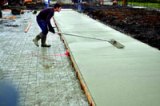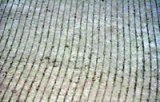White Topping-Concrete Overlay
Nagesh Puttaswamy,
Civil Infrastructure projects involve huge investment from the Government and are expected to provide long lasting services. Their use stretches for several generations during which society will experience striking changes. This long time span means that future developments in the transport of goods and people must be assessed and planned well in advance in order to make the right choices, not only for today but also for tomorrow.
The combination of constant increase in the number of road vehicles and the subsequent rise in traffic volumes and axle loads speed up developments like congestion, wear and tear of structures and, last but not least, air pollution and noise emissions. As this process goes on, the road sector faces huge challenges, including ambitious demands such as better, quicker and cheaper production, construction and maintenance. To minimize downtime of roads for maintenance activities, the overall quality of the constructions has to be upgraded. The time slots available for repair and rehabilitation works are becoming tighter and tighter, which means that maintenance techniques have to be speeded up. Furthermore, the environmental regulations with respect to air pollution and noise emissions by traffic and the use of natural raw materials are becoming more and more stringent.
Looking ahead into the future and considering the tremendous increase in road use, there is a need to look into the existing road systems, strengthen and make them maintenance free ensuring longer service life. One such experiment using the 'Thin White Topping' technique carried out in Bangalore City is discussed here along with design details, construction details, pre-overlay works, quality monitoring and machinery used.
'White Topping' refers to concrete overlay on an existing bituminous pavement to ensure longer service life, economical alternative (based on life cycle costing) apart from being environment friendly.
Introduction
Concrete Overlay in Progress
Concrete Roads were first built by Romans (300 BC - 476 AD). They were quite innovative in the construction with the use of innovative materials viz., use of `Pozzolana’ cement from the village Pozzouli near Italy, horse hairs as fibres in concrete, admixtures in their primitive form (like animal fat, milk & blood). These roads, scientifically designed and constructed had a long life and thus lead to the adage ` all (concrete) roads lead to Rome’.
Portland Cement Concrete (PCC) overlay on an existing bituminous pavement is commonly known as White topping. The principal purpose of an overlay is either to restore or to increase the load carrying capacity or both, of the existing pavement. In achieving this objective, overlays also restore the ride-ability of the existing pavements which have suffered rutting and deformations, in addition to rectifying other defects such as loss of texture.
In our country, bituminous overlays have been popularly constructed in the past mainly due to abundant supply of bitumen, its amenability to stage construction and manageable traffic conditions, in terms of volume and axle loads in addition to the comfort levels of construction methods among engineers. It was also making economic sense to make bituminous pavements as it was relatively cheaper.
Fig: 1 Milled Surface of Road
In recent times all these advantages are reversed viz., petroleum industry is using refined processing technology leading to reduction in the production of bitumen leading to increased imports, favourable cost economics of cement concrete and rapidly changing traffic scenario (in terms of volume as well as axle loads). In addition, rapid developments in concrete material technology and mechanization (both in concrete production & its laying) are favouring concrete overlays as a sustainable option. In recent times PPP (Public-Private Partnership) models are becoming popular in road construction shifting the focus on selection of overlays based on life-cycle costs rather than initial costs. India is currently producing about 240 million tonnes of cement and cement industry is quite matured and equipped to meet the challenges in terms of various grades of cements as well as high quality blended cements suitable for making Pavement Quality Concrete (PQC).
Concrete overlays have been used to rehabilitate bituminous pavements since 1918 in USA. There has been a renewed interest in White Topping, particularly on Thin White Topping (TWT) and Ultra-Thin White Topping (UTWT) over Conventional White Topping. Based on the types of interface provided and the thickness of overlay, classification is as follows:
- Conventional White topping - which consists of PCC overlay of thickness 200 mm or more, which is designed & constructed without consideration of any bond between existing overlay & underlying bituminous layer (without assuming any composite action).
- Thin White topping (TWT) - which has PCC overlay between 100 – 200 mm. It is designed either considering bond between overlay & underlying bituminous layer or without consideration of bond. High strength concrete (M 40 or higher) is normally used to take care of flexure requirement. Joints are at shorter spacing of 0.6 to 1.25 m.
- Ultra-Thin White topping (UTWT) - which has PCC overlay of less than 100 mm. Bonding between overlay & underlying bituminous layer is mandatory. To ensure this, the existing layer of bitumen is milled (to a depth of 30 - 40 mm). Joints are provided at a spacing of 0.6 to 1.25 m.
Advantages of White topping
- Reduced thickness - due to thickness of overlay remaining constant for over 2 decades.
- Fast-Track construction - making use of innovations in concrete technology & batch mixing, concretes can be designed to have 3 - days' compressive (& flexural) strength, so as to open the road for traffic within 5 days of construction.
- Reduced maintenance - as the concrete overlays live for over 2 decades, with least maintenance.
- Cost-effective compared to asphalt overlays - when Life Cycle Cost is taken into consideration.
- Improved service life - with better riding quality, improved fuel efficiency of vehicles.
- Little pre-overlay repairs.
- Improvement in safety in view of the increased reflection of light - particularly on city roads, it would save 24 % less electricity compared to flexible pavements.
- Reduction in operational costs and lower absorption of solar energy.
- Improving the environmental benefits - as concrete roads are much greener and less polluting.
Case Study
Fig : 2 Pavar Machine in Operation
The trial stretch of white topping was carried out located on Hosur Road in Bangalore, South India. The details of the existing bituminous road and the other data are as in Table 1 below:
|
1
|
CBR
|
8 to 10
|
|
2
|
Commercial vehicles per day
|
1000
|
|
3
|
Temp differential at Bangalore
|
17.3 deg C
|
|
4
|
Thickness of bituminous layer
|
4” to 7”
|
|
5
|
Base (40 mm metal) thickness
|
4” to 9”
|
|
6
|
Road width
|
100’
|
|
7
|
Length of road
|
350 m
|
|
8
|
Concrete grade
|
M 45
|
|
9
|
Axle load
|
16 T
|
Design of Pavement and Concrete Mix
 |
 |
|
Fig3: Bull Float
Operation to
Smoothen Surface
|
Fig: 4 Surface Texturing
with
wire Brush
|
Design of the overlay was carried out using Westergaard's Equation and warping stress as per IRC: 58 -2002 and IRC: SP: 76 - 2008. Total stress (including temperature stress) was obtained as 30.83 Kg/cm2 and corresponding flexural strength requirement was 4.7 MPa. Thickness of white topping was 150 mm. Concrete mix design was arrived at by evaluating trial mixes and the design mix was arrived at with a cement content of 430 kgs, fly ash - 30 kgs, with a w/c ratio of 0.283, achieving a slump of 40 - 60 mm at site.
Details of Construction
In order to achieve the desired advantages of concrete roads, three essential conditions need to be satisfied.
- Production of concrete in a RMC plant or in a dedicated batching plant.
- Using either fixed form or slip form mechanical pavers
- Strict quality control at site including testing of fresh, hardened and extracted specimens of concrete and tests on pavement quality.
In this project design and production of concrete was carried out by UltraTech RMC and Fixed Form paver was used. Quality control at site and testing were carried out as per prescribed standards.
Salient Features of Construction
1. Surface preparation- In case of TWT, bond between PCC overlay & existing bituminous pavement is at least partly desirable; in case of UTWT, effective bond is essential. To ensure this Milling of bitumen surface method was adopted. Milling can be used to remove surface distortion like cracks in the top portion and adjust cross slopes. Thickness of milling usually is in the range of 25 to 50 mm.
The minimum thickness of existing bituminous pavement (excluding the milled/scrapped thickness) shall be 75 - 100 mm to ensure a reliable & strong base.
2. Profile correction- is carried out with the objective of filling existing potholes, ruts and wide cracks and also to ensure a level surface for resting the pavement. Profile correction and correction of camber can be carried out together with a thin bituminous levelling course or with dry lean concrete (DLC).
- If the existing road surface is good & only a few localized potholes / cracks exist, they can be repaired with a bituminous mix before concreting is done.
- If potholes/ cracks are wider than 3 mm, they have to be treated with bituminous emulsion, slurry seal after trimming them to shape and cleaning out loose fragments with compressed air. Milling of the existing surface also addresses this problem.
3. Laying of PQC- is quite similar to the construction of new concrete pavement. As mentioned above, concrete should be made either in an RMC or in a weigh batching plant. Use of either fixed form pavers or slip form paver machines is an essential ingredient for getting a good quality pavement. In the current project, rods of 1 m length as tie rods @ 500mm c/c and the paver with gang mounted vibrators equally spaced with variable rpm and three integral steel tubes with 8 Tonnes vibratory rollers for screeding, levelling, compaction and finishing were used.
4. Finishing - of the surface is mostly achieved by the paver itself. But to achieve uniform finish, a simple hand operated bull float was used when concrete is still in its fresh state. After the bull float operation, uniform surface texture was provided by using steel wire brush.
5. Curing - to avoid evaporation of surface water from concrete surface (which leads to plastic shrinkage cracks), wax based curing compound was sprayed. As an additional measure, plastic sheets are spread over the pavement surface till normal curing process starts.
6. Contraction joints - are provided by cutting groves (for a depth of one-third of the depth of white topping, 150 mm in this case) at a spacing of 1.2 m in longitudinal as well as transverse directions. The joints are cut using electrical grove machines within about 8 to 10 hours of pouring concrete. These joints are sealed with high quality sealant (either bitumen or poly sulphides) to prevent moisture and incompressible infiltration into the overlay system.
7. Load Transfer-To ensure effective load transfer across the longitudinal segments as well as transverse construction joints, tie bars and dowel bars are provided.
Test Results
Strict quality control not only during mix design and production of concrete, but also testing for quality at regular intervals (for every 50 cum of concrete) was carried out. These tests included:
- Tests conducted on fresh concrete (slump test at site)
- Tests on hardened state (compressive strength of cube & cylinder specimens for 1, 3, 7 & 28 days), split tensile strength, flexural strength of concrete beams.
- Paver machine in operation.
- Fatigue and abrasion tests on pavement quality (results awaited).
- Test on extracted specimens of concrete (core tests) would be conducted to assess the long term performance of concrete.
The results obtained are tabulated as in Table 2,3,4 and 5. The road was opened for traffic after 5 days of curing.
|
Table 2- Compressive Strength of Concrete Cubes (Total no. of samples 936)
|
|
No.
|
Sample size
|
1-day
strength (MPa)
|
3-day
strength (MPa)
|
7-day
strength (MPa)
|
28 -day
strength (MPa)
|
| |
60 cubes per test
|
Max: 24.1
Min: 21.1
Avg: 22.05
|
Max: 48.2
Min: 38.4
Avg: 43.2
|
Max: 55.2
Min: 48.4
Avg: 51.02
|
Max: 67.2
Min: 57.4
Avg: 61.8
|
|
Table 3- Compressive Strength of Concrete Cylinders (Total no. of samples 60)
|
|
No.
|
Sample size
|
28 - day strength (MPa)
|
|
|
60 per test
|
Max: 61.4
Min: 43.7
Avg: 52.45
|
|
Table 4- Flexural strength of Concrete (Total no. of samples 60)
|
|
No.
|
Sample size
|
28 - day strength (MPa)
|
|
|
60 per test
|
Max: 7.35
Min: 6.2
Avg: 6.3
|
|
Table 5- Split Tensile strength of Concrete (Total no. of samples 60)
|
|
No.
|
Sample size
|
28 - day strength (MPa)
|
| |
60 per test
|
Max: 4.01
Min: 2.92
Avg: 3.36
|
Conclusions:
Due to advances in the area of mechanization and fast track construction, concrete roads and white topping provide a sustainable as well as cost effective option for pavement construction. This technology demonstration project in Bangalore has evoked positive response from people across the spectrum viz. technical consultants, construction industry, academic & research institutions. The Government of Karnataka, BBMP and other civic agencies have come forward to adopt this technology. On behalf of the cement industry, CMA (Cement Manufacturers’ Association) has come forward to assist all those involved in the construction on concrete roads/ white topping by way of several useful publications, user-friendly software for analysis, design and estimation of quantities (and comparative cost), conducting training programs for engineers and providing the necessary technical assistance.
References
- Concrete Overlays - White topping of roads, Cement Manufacturers Association, 2010
- Tentative guidelines for conventional, thin and Ultra-thin white topping, IRC: SP: 76 - 2008, The Indian Roads Congress, New Delhi, 2008
- Handbook on Cement Concrete Roads, Cement Manufacturers Association, 2010
- Michael E. Ayers & Dale Harrington, Selection and use of concrete overlays, The Indian Concrete Journal, May 2010
- Guide to Concrete Overlays - Sustainable solutions for resurfacing and rehabilitating existing pavements, National Concrete Pavement Technology Centre, USA, Sept.2008
Dear Vinutha / kiran
Please incorporate the following corrections in white topping Article.
- Remove Table 5. Also delete mention of Table 5 in the text.
- Add ‘Construction Considerations’ before ‘Conclusion’
Construction Considerations
White topped roads are not new they have been in existence since 1918 and highways have been whitetopped since 1960s. The technology has been time tested with close observation all over the world especially the USA. Many highways have been performing par excellence for over 30 years without any structural malfunction.
Following considerations are to be kept in mind while planning for execution.
- Wide range of equipment available for preparing surface, laying & finishing the white topping of bitumen roads. We need to specify the right kind of equipment for execution depending upon the extent of damage, the design and the finish required.
- There are several advanced models of pavers available with their own advantage & disadvantage.
- Mechanised finishing equipment available but need to be used where ever possible.
- Use of high end equipment may not be possible in all locations especially in city roads & rural roads. Because of their size & logistical issues.
- Specification of materials for the specific work should be considered carefully – we can use different materials for profile corrections & pavement surface.
- Concrete need to be different for profile correction roller compacted concrete could be an option as it is quite economical.
- Care should be taken when the entire concrete laying happens at night, the early morning hour drop in temperature will lead to high temperature difference and subsequent cracks.
- We can use no fines or pervious concrete in the shoulders so that water can be drained down – proper system to be worked out.
- The entire road, drainage, services including all kinds of Underground cables should be carefully looked into while executing white topping work on city roads.
- If proper drainage is not provided all types of roads will lead to the same problem.
Author
 |
Nagesh Puttaswamy
Regional head-Technical Services
Karnataka South
Ultra Tech Cement ltd, Banglore
|